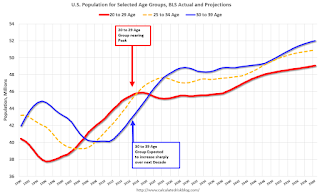by Calculated Risk on 11/15/2016 01:22:00 PM
Tuesday, November 15, 2016
The Cupboard is Full
The recent economic data has been solid. From Merrill Lynch today:
Retail spending surged 0.8% mom in October, building on a 1.0% pop in September (revised up from 0.6%). Core retail sales also came in at a robust 0.8%, which was well above expectations of 0.4%. In addition, September and August core sales were revised up to 0.3% from 0.1% and 0.1% from -0.1%, respectively. Election uncertainty looked to have had no impact on the consumer, though Hurricane Matthew may have been a drag since eating & drinking sales tumbled 0.7% mom. These data boosted our 4Q GDP tracking estimate by 0.4pp to 2.4%, as well as our 3Q estimate by 0.2pp to 3.2%And from the Atlanta Fed GDPNow:
The GDPNow model forecast for real GDP growth (seasonally adjusted annual rate) in the fourth quarter of 2016 is 3.3 percent on November 15, up from 3.1 percent on November 9. The forecast of fourth-quarter real personal consumption expenditures growth increased from 2.6 percent to 2.9 percent after this morning's retail sales report from the U.S. Census Bureau.We've seen a record 73 consecutive months of job gains (80 months if we remove the impact of the 2010 decennial census). And there is still some labor slack, so there is room for more job growth (as an example, part time for economic reasons is still elevated).
And wages are picking up.
 Click on graph for larger image.
Click on graph for larger image.This graph is based on “Average Hourly Earnings” from the Current Employment Statistics (CES) (aka "Establishment") monthly employment report. Note: There are also two quarterly sources for earnings data: 1) “Hourly Compensation,” from the BLS’s Productivity and Costs; and 2) the Employment Cost Index which includes wage/salary and benefit compensation.
The graph shows the nominal year-over-year change in "Average Hourly Earnings" for all private employees. Nominal wage growth was at 2.8% YoY in October. This series is noisy, however overall wage growth is trending up - especially over the last year and a half.

And demographics are improving!
Here is a graph of the prime working age population (this is population, not the labor force) from 1948 through October 2016.
There was a huge surge in the prime working age population in the '70s, '80s and '90s.
The prime working age labor force grew even quicker than the population in the '70s and '80s due to the increase in participation of women. In fact, the prime working age labor force was increasing 3%+ per year in the '80s!
The good news is the prime working age group has started to grow again, and is now growing at 0.5% per year - and this should boost economic activity. And it appears the prime working age group will exceed the previous peak later this year.
And the demographics for housing is even better.
 This graph shows the longer term trend for three key age groups: 20 to 29, 25 to 34, and 30 to 39 (the groups overlap).
This graph shows the longer term trend for three key age groups: 20 to 29, 25 to 34, and 30 to 39 (the groups overlap).This graph is from 1990 to 2060 (all data from BLS: current to 2060 is projected).
We can see the surge in the 20 to 29 age group (red). Once this group exceeded the peak in earlier periods, there was an increase in apartment construction. This age group will peak in 2018 (until the 2030s), and the 25 to 34 age group (orange, dashed) will peak in 2023. This suggests demand for apartments will soften in a few years.
For buying, the 30 to 39 age group (blue) is important (note: see Demographics and Behavior for some reasons for changing behavior). The population in this age group is increasing, and will increase significantly over the next decade.
These demographics are positive for home buying, and this is a key reason I expect single family housing starts to continue to increase in coming years.
Sure, there are problems. Not everyone has participated in the current expansion. Wealth and income inequality are record extremes. There is too much student debt. And climate change is posing a real threat to the economy in the future. I could offer proposals to address those issues without negatively impacting the current expansion, and we will see if those issues are addressed in the coming years.
However, the bottom line is the cupboard is full. The expansion should continue for some time. What could possibly go wrong?


